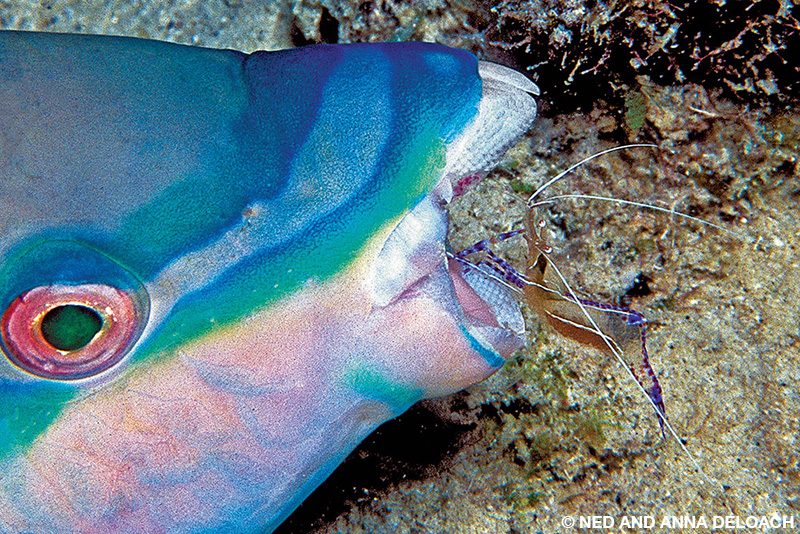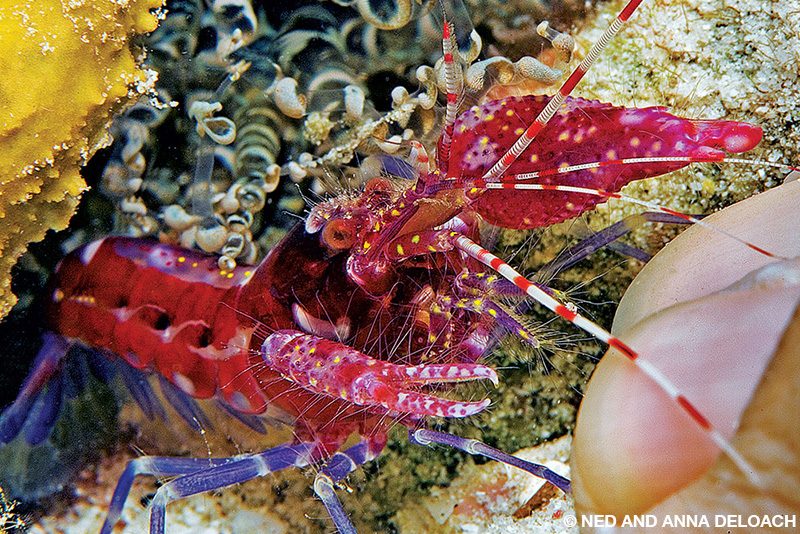The manicure
I don’t believe my wife, Anna, has any more parasites than anyone else, but after watching so many cleaner shrimp make beelines for her fingers over the years, it could make you wonder. Anna’s enjoyable interactions with parasite-picking shrimp date back to our first dives together in the Caribbean. To this day she finds it difficult to swim past the tentacles of a corkscrew anemone — the home of symbiotic Pederson cleaner shrimp — without having a quartet of the dainty do-gooders hop aboard her outstretched hand and give her a manicure.
Reef fish often suffer from persistent infestations of irritating parasites — tiny crustaceans that attach to fish to draw the blood required for their next molt. Infested fish regularly visit areas known as cleaning stations, which are populated by fish and shrimp species that have adapted to feast on the pests. Cleaners occasionally take bites of healthy skin, scales and mucus at the painful expense of their clients. Fortunately, in Anna’s case, the shrimp were after rough skin around her nails instead of parasites. One morning at an unusually active cleaning station, she took her skill to another level, attracting three different species of shrimp and a cleaning goby to her hand at the same time, which should set a record for whimsy.
Pederson shrimp perch on or near the tentacles of corkscrew anemones spiraling out from openings at the base of reef rocks and coral heads. In a mutualistic arrangement, the anemones protect the shrimp with their stinging tentacles and in exchange get a portion of their nutritional needs from the shrimps’ waste. The anemones’ tentacles also serve as signposts advertising the entire affair.

If you care to try this cleaning feat for yourself, here are a few of Anna’s tips:
- To prevent damage to coral, find an anemone extending from a rock on the sand.
- Look for shrimp waving their antennae, which indicates their desire to clean.
- Rest your palm at an angle, with your fingertips an inch away from the anemone’s tentacles.
- If they judge you worthy, two to four shrimp will sail out to your hand within seconds and begin picking at your fingers with slender mouth parts that are modified into forceps-like claws.
The shrimp have a taste for cuticles and broken skin but find cuts and scrapes irresistible. If you are ignored at first, don’t lose heart. For unexplained reasons, cleaners of all types are not always in the mood to feed. In such cases, do like the fish: Find a different anemone, and try again.
A few decades ago, while we were living in Bimini, Anna’s adventures with aquatic grooming led to a discovery. Red snapping shrimp, alone or in pairs, also inhabit the tentacles of corkscrew anemones. Unlike Pederson cleaner shrimp that float out to your hands like toy balloons, red snapping shrimp are beefy, 2-inch brutes, each armed with an oversize claw worthy of a B movie. An oncoming rush of the weapons with their accompanying pops caused us to yank back our hands, ending many a manicure. Slow hands received pinches as a reminder to stay clear of the snappers’ home.

Years ago, when first trying to understand cleaning behavior, we noticed certain flat-bodied clients such as Spanish hogfish leaning so close to the anemones that events happening behind the client remained hidden. This behavior seemed strange considering that all the other client fish positioned themselves inches away from the anemones. This conduct coupled with the snappers’ reluctance to venture outside the tentacles made us wonder if our unruly snappers could also be cleaners. It seemed unlikely, and the behavior hadn’t been reported in scientific literature. The subject was forgotten, or so I supposed, until the next day when Anna motioned me over to where she knelt next to a familiar anemone. As I settled at her side, she slipped her hand next to the tentacles. Within a minute not one but a pair of snapping shrimp busily nibbled her nails.
When we were back aboard the boat, she explained her magic: After giving the snapper problem some thought, she began to suspect that the jerks of our retreating hands caused the shrimps’ aggression. That morning, in a bit of derring-do, she placed her fingers in front of the same anemone where she had received a nip the day before. As soon as she settled her sacrificial hand, she turned away, squeezed her eyes shut and waited. Instead of a nasty pinch, she felt one tentative peck and then another. Opening first one eye and then the other, Anna watched a pair of the once-feared snapping shrimp give her the most memorable manicure of her life.
Explore More
Watch Pederson cleaner shrimp in action in this video.
© Alert Diver — Q2 2019